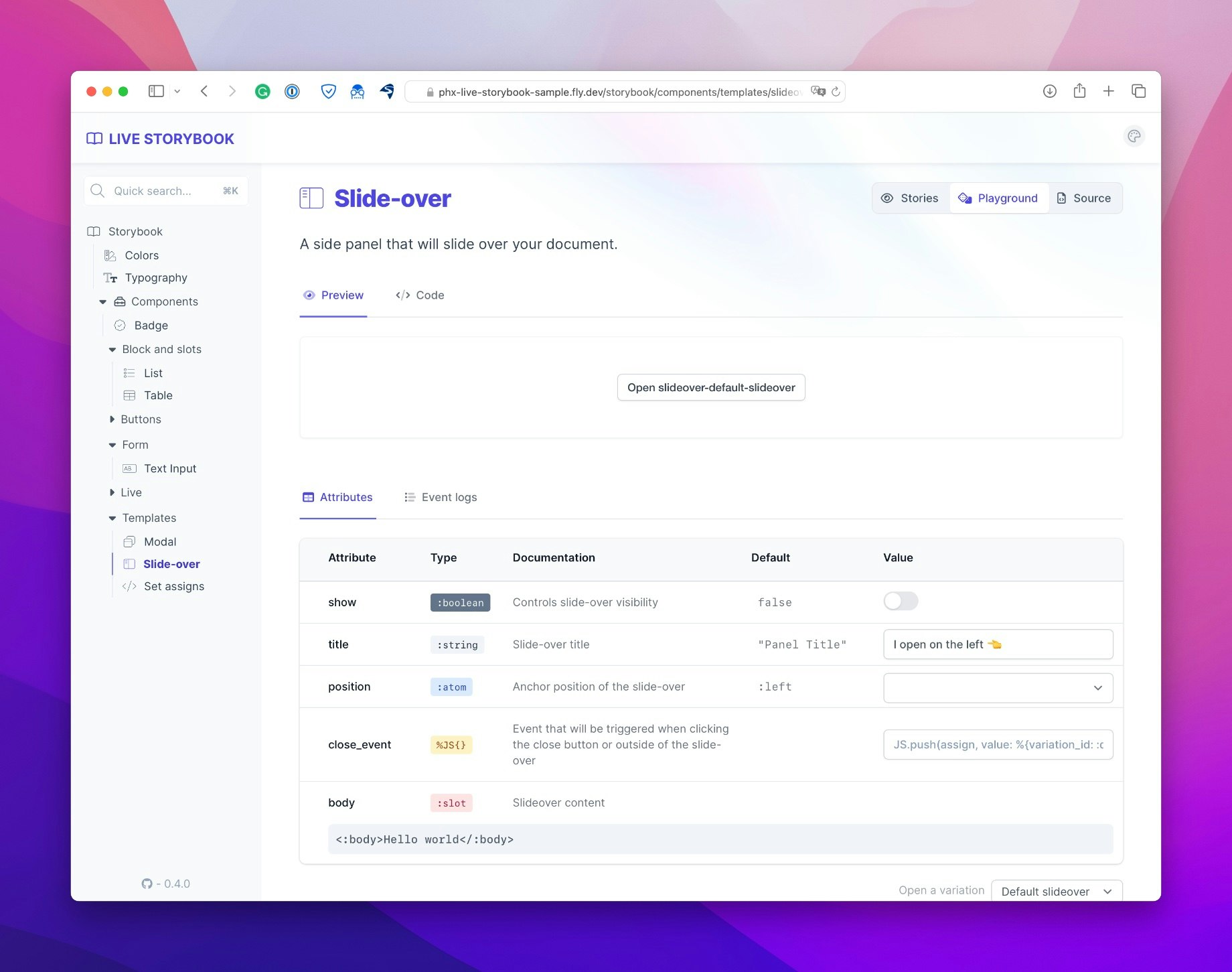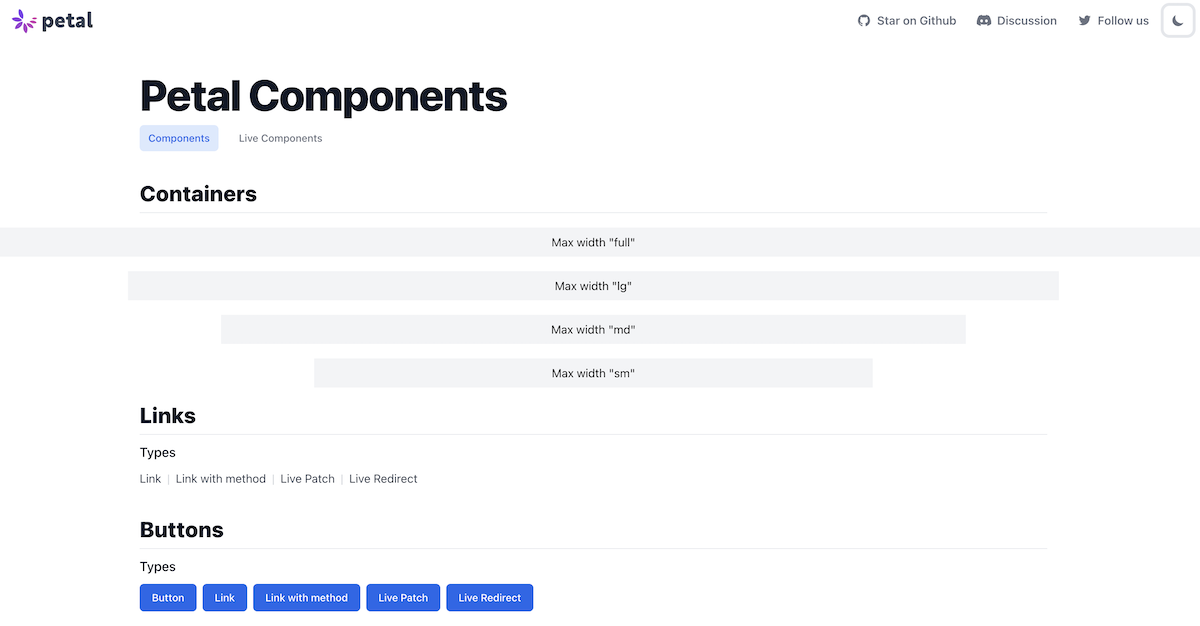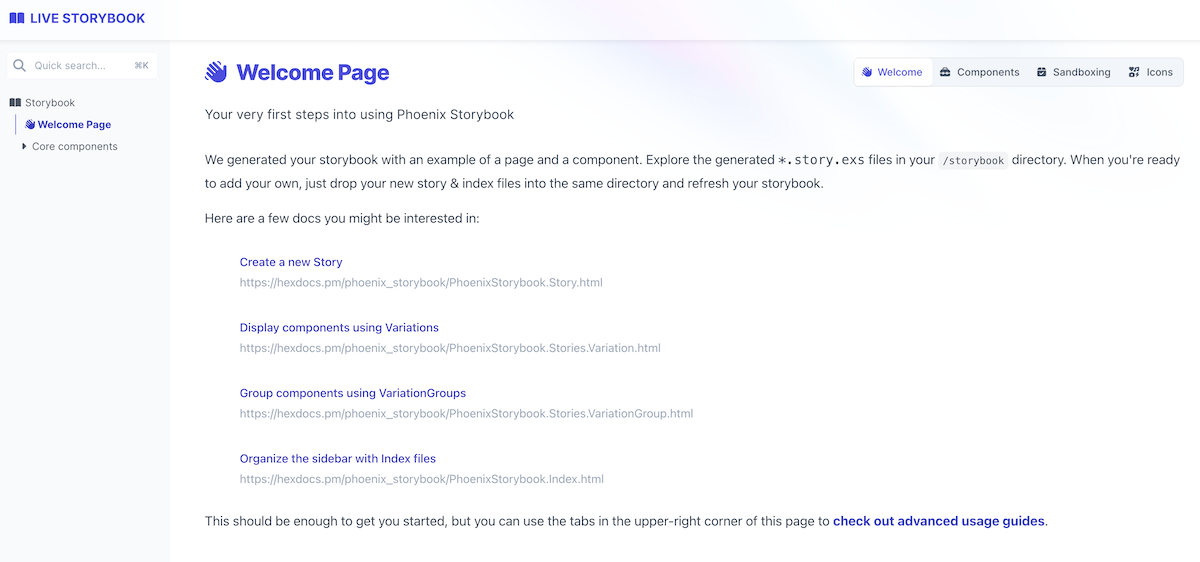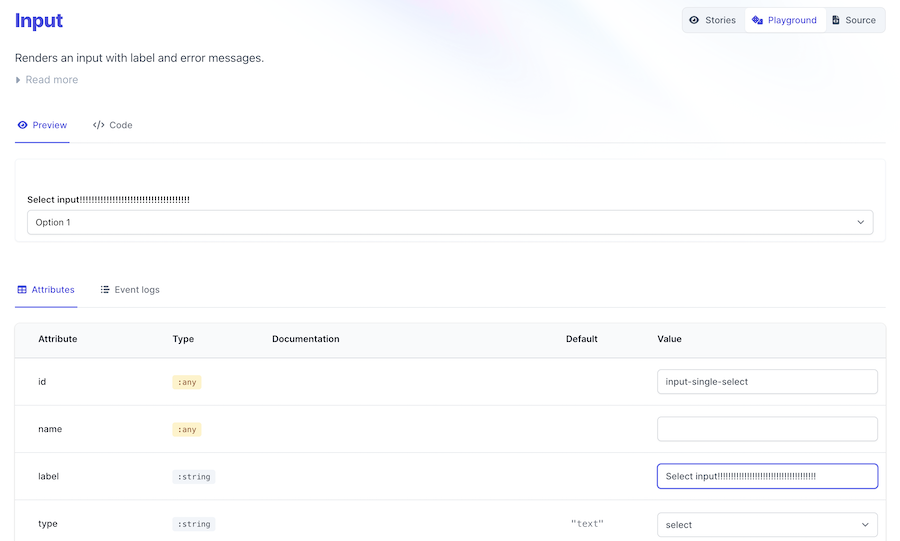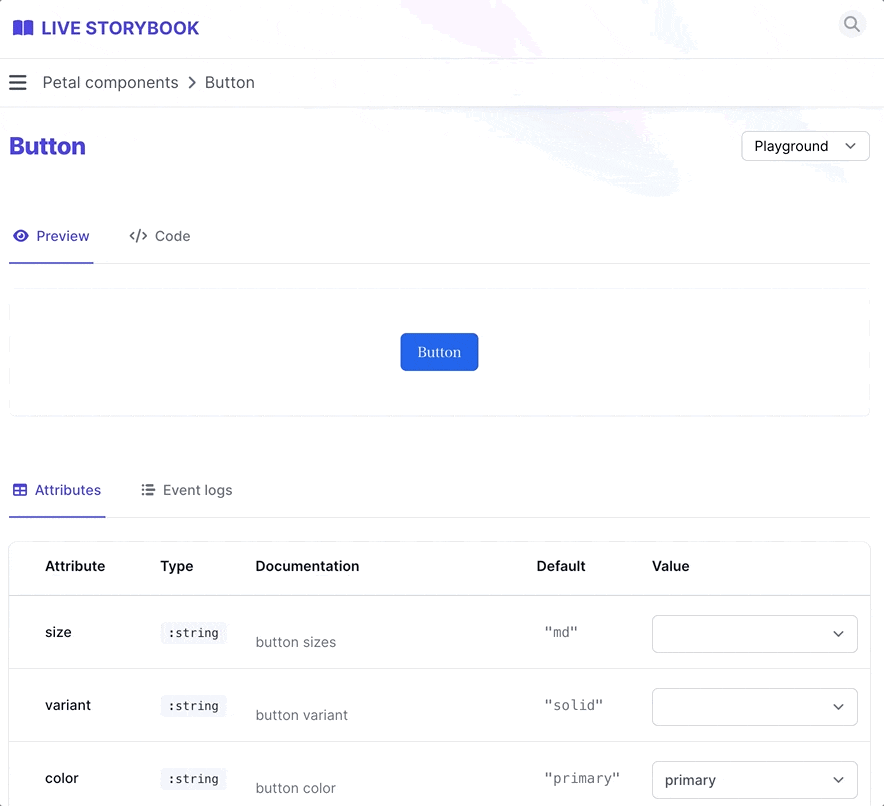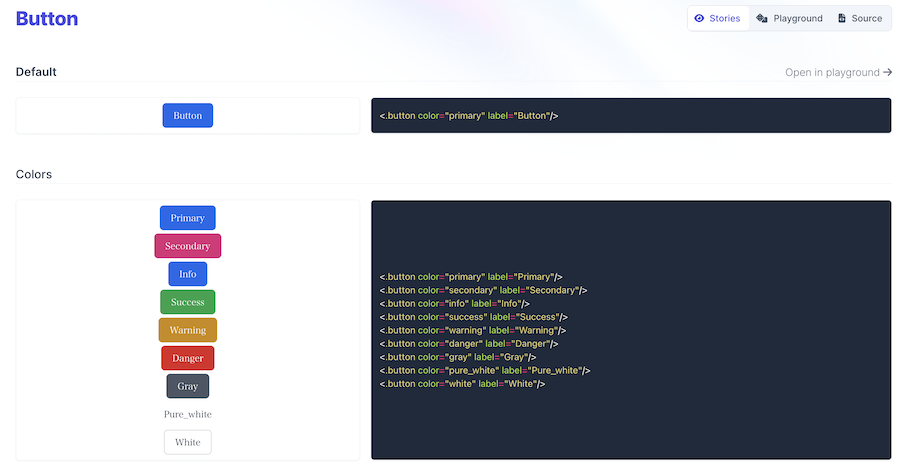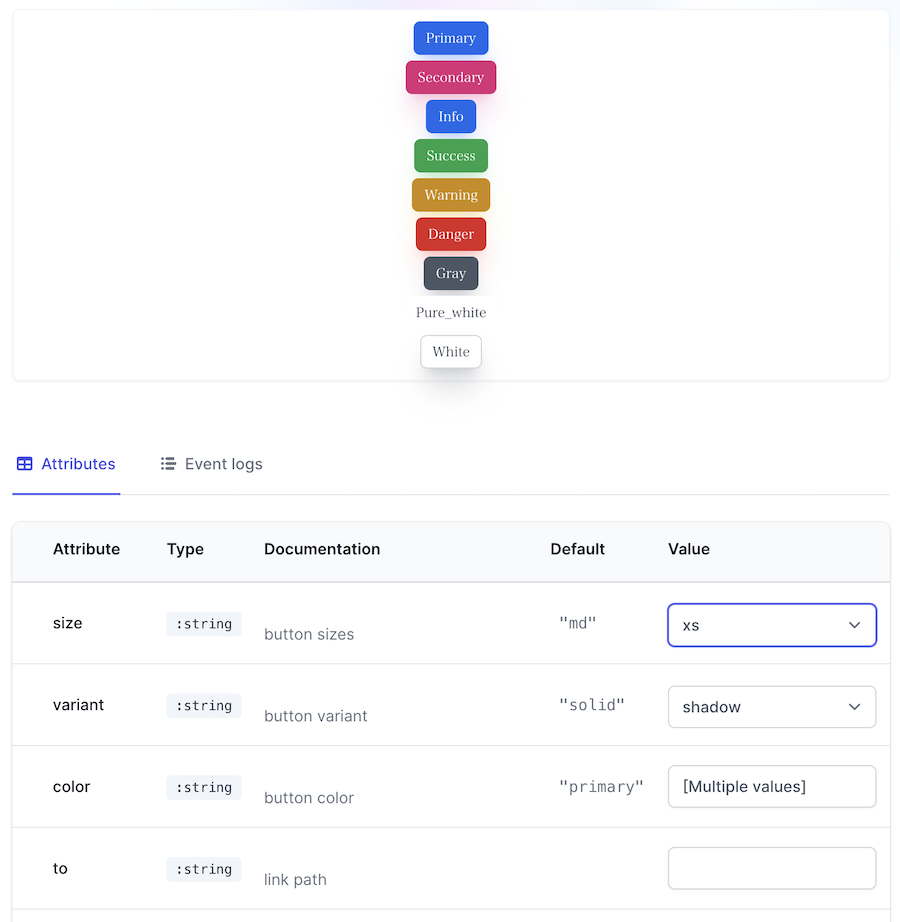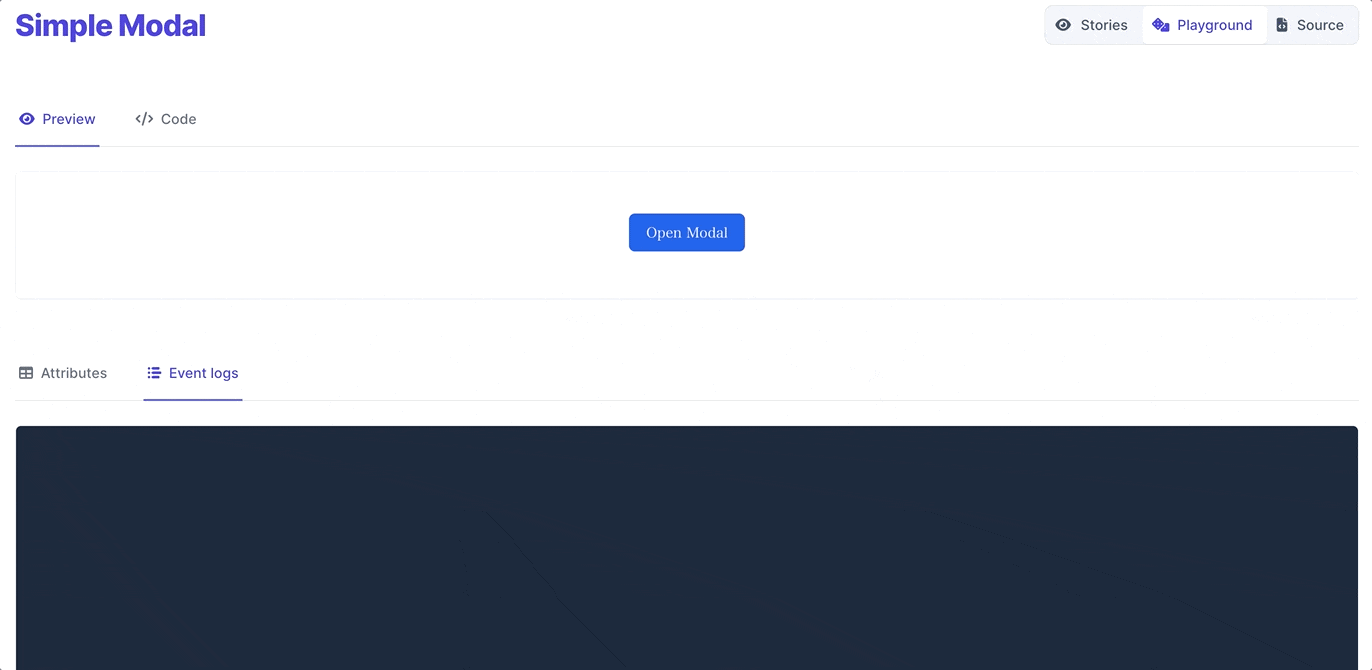はじめに
百聞は一見にしかず
以下は Phoenix Storybook 公式の画像です
バッジやスライドバーなどの部品について、どういうプロパティがあり、それをどう設定したらどういう外観、動作になるのか表示しています
これがあれば、画面に配置する前に部品=コンポーネントだけで外観、動作の確認ができます
ブラウザ上でプロパティを対話的に変えてみることも可能です
各コンポーネントにどういうプロパティがあって、どういう動作をするのか、開発者間で共有するのにも直観的で簡単です
部品を組み合わせて画面を作っていく「コンポーネントベース開発」には欠かせないツールと言えるでしょう
今回はこの Phoenix Storybook を Phoenix フレームワークのプロジェクトに組み込んでいきます
実装したコード(Petal Boilerplate のフォーク)はこちら
Storybook とは
前述の通り、 Storybook は画面のコンポーネントを開発する際、外観や動作、プロパティなどをブラウザ上で動かしながら確認できるツールです
本家は React 用のものですが、 Vue など他のフレームワークのバージョンも存在しています
公式の TOP には以下の文言があります
Build UIs without the grunt work
「面倒な作業のない UI 開発」です
Storybook なしの React 開発は考えたくありません
そして、 Storybook の Phoenix バージョンが Phoenix Storybook です
実行環境
実行日: 2023/02/24
- macOS Ventura 13.2.1
- Erlang/OTP 25.2.3
- Elixir 1.14.3
- Rancher Desktop 1.7.0
実行日現在、 Phoenix Storybook の Hex 上の最新は 0.4.5 ですが、 GitHub 上の最新版が Phoenix 1.7 に対応しているため、こちらを使います
元リポジトリー
今回は Petal Components を使ったボイラープレート(プロジェクトの雛形)である Petal Boilerplate に Storybook を組み込んでいきます
元のプロジェクトをそのままいじりたくたいので、フォークしてからクローンします
私の場合は https://github.com/RyoWakabayashi/petal_boilerplate にフォークしました
git clone https://github.com/RyoWakabayashi/petal_boilerplate.git
以降、このプロジェクトのディレクトリー内で作業します
cd petal_boilerplate
環境構築
依存モジュールへの追加
各モジュールについて、最新版を取ってきたいので mix.lock は消しておきます
rm -rf mix.lock
mix.exs に phoenix_storybook を追加します
...
{:phoenix_live_view, "~> 0.18.3"},
+ {:phoenix_storybook, "~> 0.5.0"},
{:floki, ">= 0.30.0", only: :test},
...
2023/02/27 Phoenix Storybook 0.5.0 がリリースされました
mix.exs の変更後、依存モジュールを取得します
mix deps.get
Storybook 用の変更
以下のコマンドを実行すると、 Storybook 用のファイルが生成されます
ただし、一部手動で変更する必要があるため、コマンド実行中に変更箇所を教えてくれます
mix phx.gen.storybook
以下、各手作業について説明します
ルーターの変更
mix phx.gen.storybook 実行中、以下のメッセージが表示されます
...
* manual setup instructions:
Add the following to your router.ex:
use PetalBoilerplateWeb, :router
import PhoenixStorybook.Router
scope "/" do
storybook_assets()
end
scope "/", PetalBoilerplateWeb do
pipe_through(:browser)
live_storybook "/storybook", backend_module: PetalBoilerplateWeb.Storybook
end
[Y to continue] [Yn]
lib/<プロジェクト名>_web/router.ex を以下のように編集し、 /storybook でストーリーブックにアクセスできるようにします
defmodule PetalBoilerplateWeb.Router do
use PetalBoilerplateWeb, :router
+ import PhoenixStorybook.Router
pipeline :browser do
...
end
pipeline :api do
plug :accepts, ["json"]
end
+ scope "/" do
+ storybook_assets()
+ end
scope "/", PetalBoilerplateWeb do
pipe_through :browser
get "/", PageController, :home
live "/live", PageLive, :index
live "/live/modal/:size", PageLive, :modal
live "/live/slide_over/:origin", PageLive, :slide_over
live "/live/pagination/:page", PageLive, :pagination
+ live_storybook "/storybook", backend_module: PetalBoilerplateWeb.Storybook
end
...
設定ファイルの変更
続いて config/config.exs を変更するように言われます
* manual setup instructions:
Add js/storybook.js as a new entry point to your esbuild args in config/config.exs:
config :esbuild,
default: [
args:
~w(js/app.js js/storybook.js --bundle --target=es2017 --outdir=../priv/static/assets ...),
...
]
[Y to continue] [Yn]
config/config.exs の JavaScript ビルドに関する設定に js/storybook.js を追加します
config :esbuild,
version: "0.15.5",
default: [
args:
- ~w(js/app.js --bundle --target=es2017 --outdir=../priv/static/assets --external:/fonts/* --external:/images/*),
+ ~w(js/app.js js/storybook.js --bundle --target=es2017 --outdir=../priv/static/assets --external:/fonts/* --external:/images/*),
cd: Path.expand("../assets", __DIR__),
env: %{"NODE_PATH" => Path.expand("../deps", __DIR__)}
]
また config/config.exs を変更するよう言われます
* manual setup instructions:
Add a new Tailwind build profile for css/storybook.css in config/config.exs:
config :tailwind,
...
default: [
...
],
storybook: [
args: ~w(
--config=tailwind.config.js
--input=css/storybook.css
--output=../priv/static/assets/storybook.css
),
cd: Path.expand("../assets", __DIR__)
]
[Y to continue] [Yn]
config/config.exs の Tailwind CSS に関する設定について、 Storybook 用の設定を追加します
config :tailwind,
version: "3.2.4",
default: [
...
- ]
+ ],
+ storybook: [
+ args: ~w(
+ --config=tailwind.config.js
+ --input=css/storybook.css
+ --output=../priv/static/assets/storybook.css
+ ),
+ cd: Path.expand("../assets", __DIR__)
+ ]
今度は config/dev.exs を変更するよう言われます
* manual setup instructions:
Add a new endpoint watcher for your new Tailwind build profile in config/dev.exs:
config :petal_boilerplate_web, PetalBoilerplateWeb.Endpoint,
...
watchers: [
...
storybook_tailwind: {Tailwind, :install_and_run, [:storybook, ~w(--watch)]}
]
[Y to continue] [Yn]
config/dev.exs のリロード用監視先に Storybook 用の設定を追加します
config :petal_boilerplate, PetalBoilerplateWeb.Endpoint,
...
watchers: [
esbuild: {Esbuild, :install_and_run, [:default, ~w(--sourcemap=inline --watch)]},
- tailwind: {Tailwind, :install_and_run, [:default, ~w(--watch)]}
+ tailwind: {Tailwind, :install_and_run, [:default, ~w(--watch)]},
+ storybook_tailwind: {Tailwind, :install_and_run, [:storybook, ~w(--watch)]}
]
再び config/dev.exs の変更を求められます
* manual setup instructions:
Add a new live_reload pattern to your endpoint in config/dev.exs:
config :petal_boilerplate_web, PetalBoilerplateWeb.Endpoint,
live_reload: [
patterns: [
...
~r"storybook/.*(exs)$"
]
]
[Y to continue] [Yn]
config/dev.exs の LiveReload 監視先に Storybook のコードを追加します
config :petal_boilerplate, PetalBoilerplateWeb.Endpoint,
live_reload: [
patterns: [
...
- ~r"lib/petal_boilerplate_web/(controllers|live|components)/.*(ex|heex)$"
+ ~r"lib/petal_boilerplate_web/(controllers|live|components)/.*(ex|heex)$",
+ ~r"storybook/.*(exs)$"
]
]
フォーマッターの変更
最後に .formatter.exs の変更を要求されます
* manual setup instructions:
Add your storybook content to .formatter.exs
[
import_deps: [...],
inputs: [
...
"storybook/**/*.exs"
]
]
[Y to continue] [Yn]
.formatter.exs の入力元に Storybook のコードを追加します(横に長くなるので整えています)
- inputs: ["*.{heex,ex,exs}", "priv/*/seeds.exs", "{config,lib,test}/**/*.{heex,ex,exs}"],
+ inputs: [
+ "*.{heex,ex,exs}",
+ "priv/*/seeds.exs",
+ "{config,lib,test}/**/*.{heex,ex,exs}",
+ "storybook/**/*.exs"
+ ],
これで mix gen.phx.storybook の実行が完了します
この時点でサンプルの Storybook も生成されていますが、あくまでもサンプルなので動かないものもあります
DB 構築
すでに DB を別途用意している場合は不要ですが、まだの場合は PostgreSQL の DB を構築します
今回は Docker コンテナで PostgreSQL を起動します
docker-compose.yml を以下の内容で作成します
version: "3.8"
services:
db:
image: postgres:14.4
restart: always
environment:
- POSTGRES_PASSWORD=postgres
- POSTGRES_USER=postgres
ports:
- 5432:5432
volumes:
- db:/var/lib/postgresql/data
volumes:
db:
driver: local
コンテナを起動します
docker-compose up -d
セットアップを実行します
mix setup
CSS の修正
Petal Boilerplate では assets/css/app.css を以下のように修正する必要がありました
@import "tailwindcss/base";
-@import "../../../petal_components/assets/default.css";
+@import "../../deps/petal_components/assets/default.css";
@import "tailwindcss/components";
@import "tailwindcss/utilities";
また、生成される assets/css/storybook.css でも同じものをインポートする必要があります
@import "tailwindcss/base";
+@import "../../deps/petal_components/assets/default.css";
@import "tailwindcss/components";
@import "tailwindcss/utilities";
...
Phoenix の起動
以下のコマンドで Phoenix を起動します
mix phx.server
ブラウザで htpp://localhost:4000 を開きます
Petal Boilerplate の TOP 画面では、 Petal Components の外観が表示されます
ただし、これだと各コンポーネントをどう使えばいいのか分かりません
もちろん、ボイラープレートの lib/petal_boilerplate_web/controllers/page_html/home.html.heex を見ればコードの実例が分かるのですが、それは面倒だし、プロパティの項目や値の全量も分かりません
Storybook の表示
いよいよ Storybook の出番です
ブラウザから http://localhost:4000/storybook にアクセスします
すると、自動的に Storybook の Welcome ページに遷移します
Welcome ページでは Storybook の使い方について説明があります
左メニューにある Core components 配下がサンプルとして生成されたものです
Core components を開くと出てくる Input をクリックします
すると、した画像のように、左側に UI 、 右側にコードが表示されます
これなら「どう書いたら、どうなるのか」が一目瞭然です
下へスクロールしていくと、 Select の場合があるので、その Select の文言の右端にマウスカーソルを持っていくと、 Open in playground → のリンクが見えるで、クリックします
Playground では、プロパティを変えてみることができます
ここで色々な実験ができるわけです
Storybook の修正
サンプルで作成された Storybook のうち、 Flash と Header はエラーになります
このプロジェクトの CoreComponents の中に button 関数が存在しないためです
それぞれ以下のように修正します
Flash
storybook/core_components/flash.story.exs
defmodule Storybook.CoreComponents.Flash do
use PhoenixStorybook.Story, :component
alias Elixir.PetalBoilerplateWeb.CoreComponents
def function, do: &CoreComponents.flash/1
- def imports, do: [{CoreComponents, [button: 1, show: 1]}]
+ def imports, do: [
+ {PetalComponents.Button, [button: 1]},
+ {CoreComponents, [show: 1]}
+ ]
...
修正後に Flash の Storybook を開くと、 Open Flash ボタンクリックで画面右上にメッセージが表示されます
Header
storybook/core_components/header.story.exs
defmodule Storybook.CoreComponents.Header do
use PhoenixStorybook.Story, :component
alias Elixir.PetalBoilerplateWeb.CoreComponents
def function, do: &CoreComponents.header/1
- def imports, do: [{CoreComponents, [button: 1]}]
+ def imports, do: [{PetalComponents.Button, [button: 1]}]
...
こちらも修正後に Header を開くとヘッダーのプレビューを見ることができあます
Storybook の作成
では、自分で Storybook を作ってみましょう
バリエーション
以下の内容で storybook/petal_components/button.story.exs を作成します
defmodule Storybook.PetalComponents.Button do
use PhoenixStorybook.Story, :component
def function, do: &PetalComponents.Button.button/1
def variations do
[
%Variation{
id: :default,
attributes: %{
label: "Button",
color: "primary"
}
}
]
end
end
def function, do: ... で Storybook の対象にしたい関数(コンポーネント)を指定します
def variations do ... end で Storybook に表示したいプロパティのバリエーションを指定します
ファイルを追加すると、自動的に左メニューにも追加されます
Playground で色々変えてみましょう
外観を自由自在に変化させられるので、非常に便利ですね
バリエーショングループ
VariationGroup を使うと、パラメーターを変化させた複数のコンポーネントをグループ化できます
先ほどの Storybook を以下のように書き換えます
defmodule Storybook.PetalComponents.Button do
use PhoenixStorybook.Story, :component
@colors ~w(primary secondary info success warning danger gray pure_white white)a
def function, do: &PetalComponents.Button.button/1
def variations do
[
%Variation{
id: :default,
attributes: %{
label: "Button",
color: "primary"
}
},
%VariationGroup{
id: :colors,
variations:
for color <- @colors do
%Variation{
id: color,
attributes: %{
color: to_string(color),
label: String.capitalize("#{color}")
}
}
end
},
]
end
end
すると、以下のように表示されます
一度に並べて表示できるので、違いが分かりやすいです
この状態で Playground に行くと、変化させた項目には [Multiple values] と表示されて変更不可になっています
それ以外の項目を変更すると、まとめて全部のボタンが変化します
イベント
Playground では、 JavaScript から Elixir に Push されたイベントをログとして表示できます
これでちゃんとイベントが発生しているか、イベントの内容がどうなっているか確認できます
以下のようなコンポーネント(Petal Components の Modal を改造したもの)を作ります
モーダルが閉じたとき、 close_modal のイベントを Push しています
lib/petal_boilerplate_web/components/simple_modal.ex
defmodule PetalComponents.SimpleModal do
use Phoenix.Component
alias Phoenix.LiveView.JS
import PetalComponents.Helpers
attr(:title, :string, default: nil, doc: "modal title")
attr(:close_modal_target, :string,
default: nil,
doc:
"close_modal_target allows you to target a specific live component for the close event to go to. eg: close_modal_target={@myself}"
)
attr(:max_width, :string,
default: "md",
values: ["sm", "md", "lg", "xl", "2xl", "full"],
doc: "modal max width"
)
attr(:rest, :global)
slot(:inner_block, required: false)
def modal(assigns) do
assigns =
assigns
|> assign(:classes, get_classes(assigns))
~H"""
<div {@rest} id="modal" phx-mounted={init_modal()}>
<div id="modal-overlay" class="pc-modal__overlay" aria-hidden="true"></div>
<div class="pc-modal__wrapper" id="modal-wrapper" role="dialog" aria-modal="true">
<div
id="modal-content"
class={@classes}
phx-click-away={hide_modal(@close_modal_target)}
phx-window-keydown={hide_modal(@close_modal_target)}
phx-key="escape"
>
<!-- Header -->
<div class="pc-modal__header">
<div class="pc-modal__header__container">
<div class="pc-modal__header__text">
<%= @title %>
</div>
<button phx-click={hide_modal(@close_modal_target)} class="pc-modal__header__button">
<div class="sr-only">Close</div>
<svg class="pc-modal__header__close-svg">
<path d="M7.95 6.536l4.242-4.243a1 1 0 111.415 1.414L9.364 7.95l4.243 4.242a1 1 0 11-1.415 1.415L7.95 9.364l-4.243 4.243a1 1 0 01-1.414-1.415L6.536 7.95 2.293 3.707a1 1 0 011.414-1.414L7.95 6.536z" />
</svg>
</button>
</div>
</div>
<!-- Content -->
<div class="pc-modal__content">
<%= render_slot(@inner_block) %>
</div>
</div>
</div>
</div>
"""
end
def init_modal() do
%JS{}
|> JS.remove_class("overflow-hidden", to: "body")
|> JS.hide(to: "#modal-overlay")
|> JS.hide(to: "#modal-content")
|> JS.hide(to: "#modal-wrapper")
|> JS.hide(to: "#modal")
end
# The live view that calls <.modal> will need to handle the "close_modal" event. eg:
# def handle_event("close_modal", _, socket) do
# {:noreply, push_patch(socket, to: Routes.moderate_users_path(socket, :index))}
# end
def hide_modal(close_modal_target \\ nil) do
js =
%JS{}
|> JS.remove_class("overflow-hidden", to: "body")
|> JS.hide(
transition: {
"ease-in duration-200",
"opacity-100",
"opacity-0"
},
to: "#modal-overlay"
)
|> JS.hide(
transition: {
"ease-in duration-200",
"opacity-100 translate-y-0 md:scale-100",
"opacity-0 translate-y-4 md:translate-y-0 md:scale-95"
},
to: "#modal-content"
)
|> JS.hide(to: "#modal-wrapper")
|> JS.hide(to: "#modal")
if close_modal_target do
JS.push(js, "close_modal", target: close_modal_target)
else
JS.push(js, "close_modal")
end
end
# We are unsure of what the best practice is for using this.
# Open to suggestions/PRs
def show_modal(js \\ %JS{}) do
js
|> JS.add_class("overflow-hidden", to: "body")
|> JS.show(
transition: {
"ease-in duration-300",
"opacity-0",
"opacity-100"
},
to: "#modal-overlay"
)
|> JS.show(
transition: {
"transition ease-in-out duration-200",
"opacity-0 translate-y-4",
"opacity-100 translate-y-0"
},
to: "#modal-content"
)
|> JS.show(to: "#modal-wrapper", display: "flex")
|> JS.show(to: "#modal")
end
defp get_classes(assigns) do
opts = %{
max_width: assigns[:max_width] || "md",
class: assigns[:class] || ""
}
base_classes = "pc-modal__box"
max_width_class = "pc-modal__box--#{opts.max_width}"
custom_classes = opts.class
build_class([max_width_class, base_classes, custom_classes])
end
end
このモーダルは show_modal で開き、 hide_modal で閉じます
Storybook を以下のように実装しましょう
モーダルが開いたり閉じたりするのを見るため、ボタンを用意しています
storybook/petal_components/simple_modal.story.exs
defmodule Storybook.PetalComponents.SimpleModal do
use PhoenixStorybook.Story, :component
def function, do: &PetalComponents.SimpleModal.modal/1
def imports, do: [
{PetalComponents.Button, [button: 1]},
{PetalComponents.SimpleModal, [hide_modal: 0, show_modal: 0]}
]
def template do
"""
<.button phx-click={show_modal()} lsb-code-hidden>
Open Modal
</.button>
<.lsb-variation/>
"""
end
def variations do
[
%Variation{
id: :default,
attributes: %{
title: "Modal"
},
slots: [
"Hello Modal",
"""
<div class="flex justify-end">
<.button phx-click={hide_modal()}>
Close
</.button>
</div>
"""
]
}
]
end
end
Playground で下部のタブを Event logs にしていると、モーダルを閉じたときにイベントが来たのを確認できます
まとめ
これで部品作りが楽になったので、色々な部品を作ってみましょう

